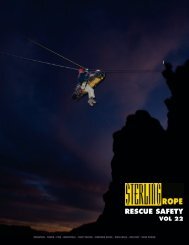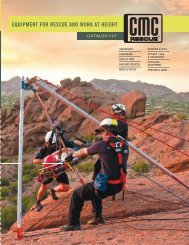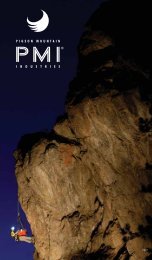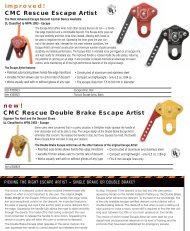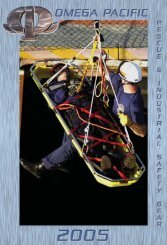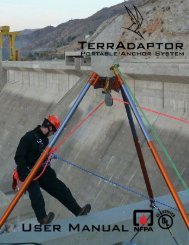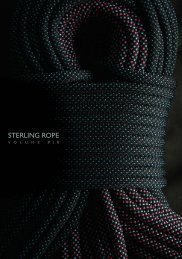ROPE - Rescue Consulting Canada
ROPE - Rescue Consulting Canada
ROPE - Rescue Consulting Canada
You also want an ePaper? Increase the reach of your titles
YUMPU automatically turns print PDFs into web optimized ePapers that Google loves.
LIFE SAFETY <strong>ROPE</strong><br />
No single type of rope is ideal for every type of operation. Before purchasing, consider your intended use carefully and choose<br />
the PMI rope(s) most appropriate for the job you plan to do. Ropes for rappelling or lowering a single person will have different<br />
characteristics than ropes for lead climbing. <strong>Rescue</strong> ropes for heavy loads will differ from ropes used for water rescue. Other<br />
considerations include environmental effects, abrasion, ease of handling, and potential for chemical contamination.<br />
STATIC KERNMANTLE<br />
Traditional American style rigging and rescue rope. With less than 6% elongation at 10% of its minimum<br />
breaking strength, it is an excellent choice for lowering and raising because it is very durable and will not<br />
‘creep’ under load like low stretch ropes will.<br />
Low Stretch KERNMANTLE<br />
According to Cordage Institute standards, measured elongation of Low Stretch rope must be between<br />
6-10% at 10% of its rated minimum breaking strength (MBS). Low Stretch rope is common in Rope Access.<br />
It often has a nice hand or knotability, and may be preferable for belaying heavy loads.<br />
Alternative Fibers<br />
Before deciding which rope is right for your task, consider the benefits of each fiber. While nylon has more<br />
ability to absorb shock, polyester elongates less under load. This means that you should take extra precautions<br />
to prevent shock loading if you choose to use a static rope made with polyester, but used in the right<br />
application, polyester can be a benefit to your system.<br />
9 mm 10 mm 11 mm 12.5 mm 16 mm<br />
Expedition Caving,<br />
Personal Escape,<br />
Fixed Lines. Excellent<br />
strength/weight ratio<br />
Caving, Rope Access,<br />
Single Person Use.<br />
Preferred by experienced<br />
professionals.<br />
Rigging, Caving, Rope<br />
Access, & <strong>Rescue</strong>. A<br />
practical multi - purpose<br />
rope.<br />
Fire-<strong>Rescue</strong>, Rigging in<br />
harsh environments. A<br />
reliable staple on any<br />
fire truck.<br />
An extra heavy<br />
duty work horse<br />
that is easy to grip.<br />
<strong>ROPE</strong> STRENGTH<br />
Often a key point in rope selection, rope<br />
strength is a function of what the rope is<br />
made of, how it is made, and how much<br />
fiber is in it. Desired strength must also<br />
be balanced against other factors such as<br />
diameter (compatibility with other gear),<br />
weight, flexibility, and anticipated use.<br />
How strong is strong enough?<br />
PMI’s 11 mm Classic Static Rope has an<br />
MBS, commonly referred to as “minimum<br />
breaking strength”, of about 6,700 lbf.<br />
PMI Classic 12.5 mm has an MBS of over<br />
9,000 lbf. This means that this is how<br />
strong you can expect the rope to be (excluding<br />
variables such as knots, rigging,<br />
etc.), not how much force you should apply<br />
to it.<br />
<strong>ROPE</strong> P<strong>ROPE</strong>RTIES<br />
Static or Low Stretch ropes intended for life safety applications are always clearly noted as being for<br />
that purpose, and should be labeled in accordance with appropriate life safety equipment standards.<br />
In the U.S., test methods for static and low stretch ropes are set by the Cordage Institute. Look for<br />
ropes tested to Cordage Institute standard number CI 1801.<br />
Commodity ropes, such as clothesline, tie downs, or hardware store rope should not be used for life safety.<br />
WARNING<br />
High angle rope techniques are inherently dangerous. Please take the time to read and understand this catalog and all instructions that come with the equipment you<br />
purchase. The information in this catalog is provided for making purchasing decisions only and is NOT a substitute for competent instruction and training in safety techniques.<br />
It is the responsibility of the user of this equipment to obtain competent instruction and to take adequate precautions for safety when using this equipment. The equipment<br />
described in this catalog is designed and tested for use in rope access, rescue, confined space, climbing, mountaineering and caving. Use in any other application is at the<br />
discretion of the user.<br />
5



